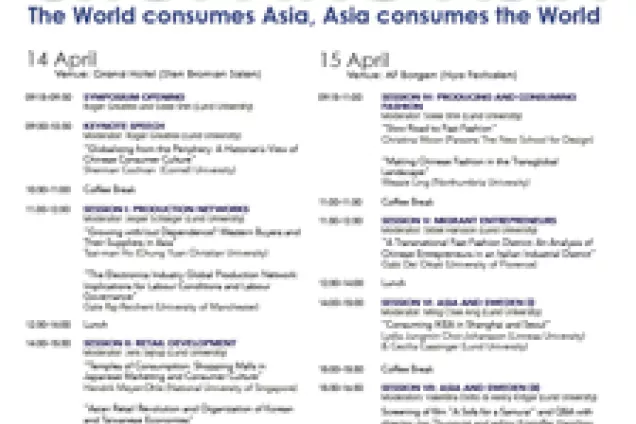Focus Asia 2015
14-16 April & 12-13 November
Shopping Asia: the world consumes Asia, Asia consumes the world.
Over the latter half of the twentieth century, Asia has emerged first as the center for global manufacturing and thereafter as a location for rising demand. These histories of changing Asian production and consumption landscapes are tied to shifting dynamics in the structure of global capitalism. The shifting power balance between large manufacturers and large retailers; revolution in logistics; changing geographies and networks of trade and production; worldwide diffusion of modern retailing; and rising middle class and consumer cultures around the world are some of the factors that have enabled recent changes in Asia’s relationship to global shopping.
The aim of the first Focus Asia in 2015 was to bring together practitioners, working in various fields of the social sciences and Asian studies, who take seriously the inter-relationships between global production and consumption landscapes, and who pose relevant questions regarding Asia’s contemporary and historical role within this nexus. The title of the symposium “Shopping Asia” had multiple meanings, pointing to the complexity within the landscape of global shopping — as the world increasingly consumes, often Western-branded, Asian-made goods, and as Asians learn to consume globally-produced products, that are often foreign-branded goods made in their own local factories. Mediating these relationships are a number of powerful intermediaries, retailers, brand-name manufacturers, contract manufacturers, and distributors, who are located between production, retail, and consumption markets.
E-Governance in Asia: Strengthening Transparency and Accountability?
Governments increasingly rely on new information and communication technology to connect with citizens. An important aspect of this e-governance is to enhance openness to empower citizens. Nonetheless, it is debated whether the digitization of government has in fact led to increased transparency, or whether governments primarily use the online interfaces to enhance social control. From a critical perspective the symposium examined the state-of-the-art of e-governance in Asia. The aim was to synthesize knowledge about the challenges of creating transparency and accountability in a digital environment. The core discussion unfolded as a juxtaposition of analyses of e-governance in different policy areas in India and China. The national-level studies are set in a comparative perspective spanning all of East and South-East Asia. The symposium thus provided an overview of the regional development of e-governance with particular focus on the pertinent issues of transparency and accountability.

Focus Asia April 2015


